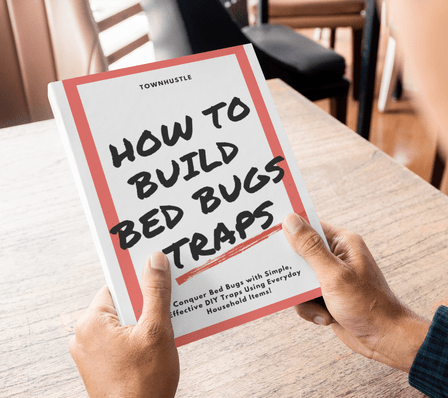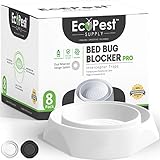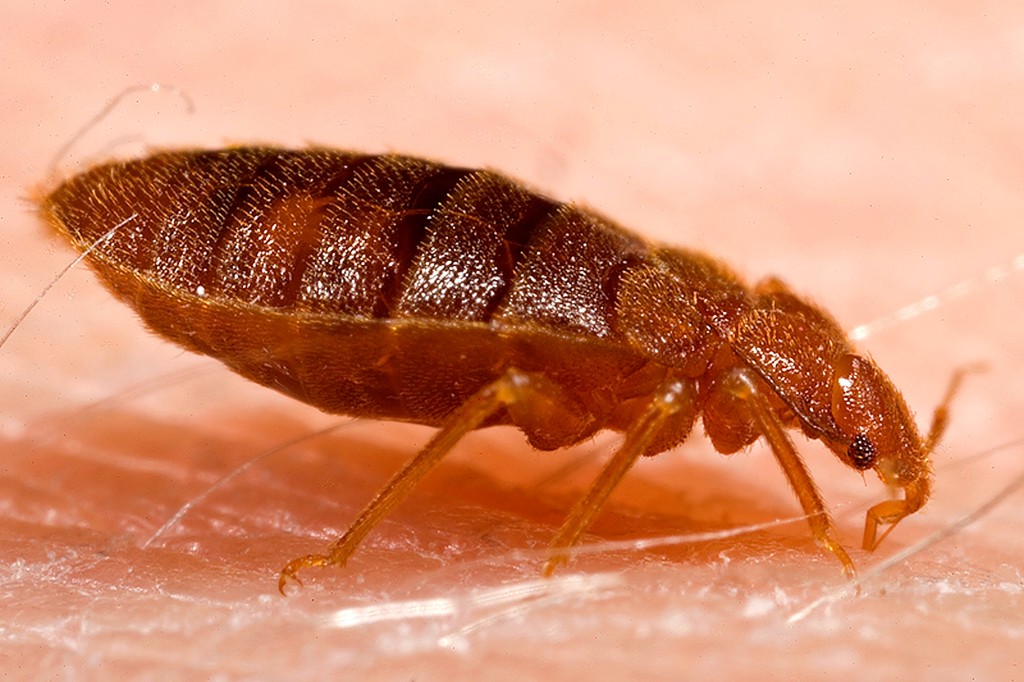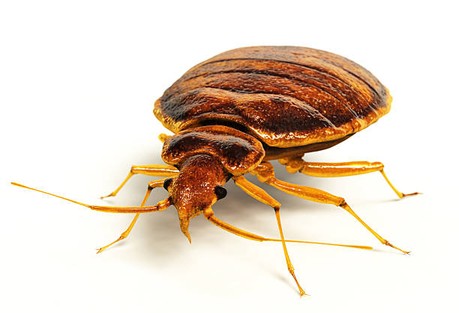Bed bug traps are quite an effective way that you can use to reduce if you have small to medium-level bed bug infestation.
Reading this article can save you a lot of hours and money! Just heading over to Amazon and searching for “Bed bug traps” won’t help you too much. You have to understand your type of infestation and furniture to pick the best product that suits your need and here we come in 🙂
There are hundreds of bed bug traps on the market. We extensively tried and tested different products and picked Top products that work well so you don’t have to spend hours researching.
However, for maximum results and efficient use of these traps, it is best to place them near a bed so the natural stimulus can attract them.
Body heat and carbon dioxide released at night by the human body naturally attract bed bugs to a sleeping person. Bed bugs crawl up the leg of a bed to reach a body to feed upon.
Bed bug traps are inventions created with the intention of intercepting bed bugs. It traps bed bugs when they try to crawl up near beds or furniture.
Another purpose of these devices is to monitor if a bed bug infestation is possible. Most bed bug traps are designed around the idea that these pests cannot climb over slippery and vertical slopes.
You can find bed bugs everywhere, specifically in a hotel room.
So we introduced different bed bug traps with a short description. Now let’s deep dive into each product and study the nitty gritty, including but not limited to its pricing, use, and Pros/Cons of each product.
Here are some of the Best Bed bug Traps that work like a charm:
Some customers have reported purchasing these traps and use them as monitoring devices to detect bed bug problems before they become bigger issues.
Smith, J. (2022)
Table of Contents
1. DIY Guide: How to Build Bed Bug Traps
Pros
- Comprehensive guide covering various DIY bed bug trap designs
- Step-by-step instructions for building and placing traps
- Most traps can be built using common household items
- Provides valuable information about bed bug behavior and habits
- Cost-effective alternative to buying commercial traps
- Integrates well with other bed bug control methods
- Teaches how to monitor and adjust trap placements for maximum effectiveness
- Careful planning
Cons
- Requires time and effort to create and maintain traps
- Some materials and tools may need to be purchased separately
- Not as aesthetically pleasing as some commercial options
The DIY Guide to Build Bed Bug Traps offers a comprehensive, cost-effective alternative to commercial bed bug traps. Most traps in this Guide can be built using common household items. This extensive guide covers a variety of DIY trap designs, including the Carbon Dioxide Trap, Dry Ice Trap, ClimbUp DIY Bed Bug Interceptor Trap, Sticky Tape Bed Bug Trap, and DIY Bed Bug Beacon Trap. In addition, the guide provides valuable information about bed bug behavior, habits, and effective trapping techniques.
Design and Functionality: Each bed bug trap design in the guide comes with detailed step-by-step instructions, making it easy to build and implement these traps in your home. Most of the traps can be built using common household items, adding convenience and cost savings. The guide also covers proper trap placement, regular monitoring, and integrating the traps with other control methods for a comprehensive approach to bed bug management.
Education and Understanding: The DIY guide teaches you how to build and use bed bug traps effectively and helps you understand bed bug habits and behavior, ensuring that you can tackle the problem more efficiently.
Cost and Value: This guide provides a cost-effective alternative to purchasing commercial traps by offering a DIY solution to bed bug trapping. Though some materials and tools may need to be purchased separately, the overall cost is generally lower than buying pre-made traps, and the convenience of using common household items adds to the value.
Limitations: While the DIY Guide to Build Bed Bug Traps provides valuable information and instructions, creating and maintaining the traps requires time and effort. Additionally, the traps may not be as aesthetically pleasing as commercial options.
Product Specs
- Type: Digital Guide
- Dimensions: Can be adapted to your needs
- Longevity: Can be used continuously
- Unit Count: Unlimited
Get the DIY Guide: How to Build Bed Bug Traps on Townhustle
2. ClimbUp Interceptors Bed Bug Traps
Pros
- Reasonably priced
- Easy to install or set up.
- Helps to prevent bugs from climbing up furniture legs
- Can be placed under furniture to capture all types of small critters
- Does not use pesticides
- Safe for use at home and the environment
Cons
- Arrives without instructions and not in original packaging, making it difficult to use
- Can be difficult to place under heavier furniture
- The Center may crack over time due to pressure from bed legs
- Captures bed bugs, but does not kill them
- Design is not considered very aesthetically pleasing
- Talcum powder is required for outer ring maintenance, but it is not included.
Product Overview: The ClimbUp bed bug trap is a product developed by Vancouver-based Milo Enterprises Inc. designed to capture bed bugs without the use of pesticides.
Design and Functionality: The ClimbUp bed bug trap features two circular areas to accommodate furniture legs. The inner wall of each ring is coated with talc, making it difficult for bed bugs to escape. It is safe for use at home and environmentally friendly as it does not use pesticides. The traps can be used continuously, with talc powder being the only component that needs replenishing once a month.
Size Compatibility: The normal version of the ClimbUp trap fits furniture legs up to 33/4 in diameter, while an XL version is available for larger bed posts. Each pack contains four traps, sufficient for a sofa or a bed.
Popularity and Performance: The ClimbUp bed bug trap is one of the most popular and highest performing products of its kind on the market.
Material and Durability: The trap is made of crack-resistant polypropylene material, making it stronger and more flexible than ordinary plastic. However, any damage to the product can compromise its effectiveness, so regular check-ups are necessary.
Limitations and Aesthetics: It is important to note that the ClimbUp bed bug trap does not kill bed bugs but only captures them, requiring disposal afterward. The trap’s design, while efficient, is not considered very aesthetically pleasing.
Product Specs
- Type: Crack-resistant polypropylene plastic
- Dimensions: 6.5″ x 4.5″
- Weight: 1.2 pounds.
- Longevity: Can be used continuously
- Unit Count: Set of 4 pieces
Get the ClimbUp Interceptors Bed Bug Traps on Amazon or Walmart or DoMyOwn or bedbugsupply.com or solutionsstores.com or Home Depot
3. EcoPest Bed Bug Blocker (Pro)
Pros
- The product is easy to use and install.
- It is a cost-effective solution for getting rid of bedbugs.
- The traps are sturdy and heavy-duty, making them effective.
- The product can be easily monitored and is designed well.
- It is a good value for the price and works great for preventing and eliminating bedbugs.
Cons
- Traps are not sticky enough to catch bugs and only catch dust.
- The traps are only one of the many tools needed to remove bedbugs from a home and may not be effective on their own.
The EcoPest bed bug trap comes in black or white color. The plastic-made traps come in a set of 8 pieces with a dimension of 6.7 x 6.1 x 6.1 inches.
EcoPest Labs has developed a series of Bed Bug Blocker traps that are specifically designed to prevent bed bugs from getting onto beds. Bed bugs do not have the ability to fly or jump, but they can easily climb into the outer reservoir of these traps. Once inside, they are unable to escape due to the slippery texture.
The EcoPest Bed Bug Blocker trap has a sturdy construction and a well-conceived design, making it an effective means of preventing bed bugs from infesting your bed. The trap is designed in a cup-style shape with a wide 4-inch internal diameter, making it large enough to fit most bedposts.
EcoPest uses durable plastic material that can withstand the weight of even larger beds without cracking or deforming. With the EcoPest Bed Bug Blocker trap, you can rest assured that your bed will remain bed bug-free.
It is one of the most popular highest performing products of its kind.
Product Specs
- Type: Cup-style shape with a wide 4-inch internal diameter
- Dimensions: 6.7 x 6.1 x 6.1 inches
- Weight: 7 oz.
- Longevity: Can be used continuously
- Unit Count: Set of 8 pieces
Get the EcoPest Bed Bug Blocker (Pro) on Amazon or Amazon or Walmart or newegg.com or premoguard.com
4. Aspectek Bed Bug Trap
Pros
- Easy to use
- Adds a level of security against bed bugs
- Easy to install
Cons
- May not be suitable for all furniture legs
- Not a guarantee that it will completely stop bed bugs from entering or leaving your home
The plastic-made traps come in a set of 4 pieces with a dimension of 6.5” x 4.5” and a weight of 7 oz. The Aspectek bed bug trap is designed to have two circular areas.
The inner circle has a diameter of 4.5 inches, along with little bumps distributed all over it. The little bumps on the trap equally distribute the pressure applied on it by the furniture placed upon it.
These knobs help reduce the possibility of any damage due to the pressure. To ease the entry of bed bugs into the traps, the Aspectek insect interceptor consists of a furrowed exterior wall.
The wall’s texture gives leverage to bed bugs so they can easily fall into the trap, and once inside, they are confined to the space between both rings. The use of talc in the Aspectek trap is essential.
To ease the entry of bed bugs into the traps, the Aspectek insect interceptor consists of a furrowed exterior wall.
The wall’s texture gives leverage to bed bugs so they can easily fall into the trap, and once inside, they are confined to the space between both rings. The use of talc in the Aspectek trap is essential.
As the powder makes it difficult for the bed bugs to crawl over the inner walls of the trap, and the pests remain confined within the device. Other than talc, the trap is completely pesticide or chemical free.
The trap is designed so it is compatible with different terrains. The inner ring of the trap has a 4.5-inch diameter which can support a variety of beds and sofas.
Since it comes in white, it makes seeing the trapped bed bugs easier.
Product Specs
- Type: plastic-made trap
- Dimensions: 6.5″ x 4.5″
- Weight: 7 oz.
- Longevity: Can be used continuously
- Unit Count: Set of 4 pieces
Get the Aspectek Bed Bug Trap on Amazon or Amazon or Walmart
5. BEAPCO Bed Bug Detector Coaster
Pros
- Made of strong and high-quality plastic material.
- Good size and discreet design, effective in keeping bugs away.
- Designed with a rough outer wall and a smooth inner wall, and is anti-slip, making it easy for the bugs to get in but difficult for them to get out.
Cons
- They are difficult to clean.
- Expensive for what they are.
- It may not be suitable for rooms with carpets or bed frames with peg-like legs.
BEAP CO. is a Canadian producer of bed bug traps. Their products aim to control the spread of bed bugs for easier elimination in a non-toxic and eco-friendly way.
The trap’s design is similar to other bed bug traps consisting of two rings, each holding bed bugs from different areas.
Product Specs
- Type: Sturdy plastic
- Dimensions: Designed to fit perfectly for a 4″x4″ footing on a Queen sized bed
- Weight: 7 oz.
- Longevity: Can be used continuously
- Unit Count: Set of 4 pieces
Get the BEAPCO Bed Bug Detector Coaster on Amazon or Walmart or Home Depot
6. TruGuard X From Shieldflex
Pros
- Eco-friendly way to detect, intercept, and monitor bed bugs
- Made from durable plastic with a super slick trench
- Easy to install and use
- Good value for the price
Cons
- Traps may be too small for some beds
- Black color makes it difficult to see if anything has been caught
Shieldflex TruGuard bedbug traps are manufactured to last. It is made up of extra-strength polymer composition. These trap interceptors are not easy to crack handling heavyweight beds. The product was constructed with a reinforced polypropylene base plate. For added durability and strength.
The trap really works. It contained and controlled the bedbugs for climbing up to hide in your bed or furniture. Crawly pesky insects got stuck inside the trap. Bedbugs are unable to come out from slippery moats. Because they cannot jump or fly. It is designed to detect, monitor, protect, and prevent your home from bedbug infestations.
It fits all sizes of furniture legs. Ideal for residential and commercial use. Easy to install, reusable. Eco-friendly and safe around kids and pets. Non-toxic.
When you purchase. It comes in two colors, white and black. Each box includes eight-bed bug interceptor traps that can be used to guard and protect two beds or other pieces of furniture.
Black is not ideal for detecting early on an infestation. Seeing the dark body of bed bugs with the white traps is easier. If you still want the black to match the furniture, you can buy a UV flashlight to see if you caught anything.
Product Specs
- Type: made with a reinforced polypropylene base plate
- Dimensions: 4″ x 4″
- Weight: 7 oz.
- Longevity: Can be used continuously
- Unit Count: Set of 8 pieces
Get the TruGuard X From Shieldflex on Amazon or Amazon
7. The Raid Bed Bug Detector Trap
Pros
- Very effective for bed bug monitoring and prevention
- Easy to use and discreet, giving peace of mind at home and when traveling
- Can be hidden under furniture and used to detect bed bug problems
Cons
- Solely a detector and does not reduce the number of bugs
An adhesive sticks to the trapped bed bugs inside the trap, preventing them from escaping.
The trap is made up of low-grade plastic as it is disposable and best suited as a traveling companion to avoid bed bug bites in hotel rooms.
About ¾ of the entire surface of the trap has a dark color; the rest of the portion has a transparent section. The dark color section serves as bed bug bait, while the clear section makes the visibility of trapped bed bugs easy to see.
According to the product labels, it needs to be placed around furniture where a bed bug victim may lie down for comfort, especially in dark areas. The product comes in a pack of 8 traps with a diameter of 1.8 inches and a weight of 0.3 oz.
Since the Raid bed bug detector comes in a pack of 8 traps they can be spread out over several pieces of furniture, increasing the possibility of catching a bed bug.
Once the bed bugs have been trapped inside the trap, they must be disposed of immediately. The product provides only short-term relief. The Raid bed bug detector trap is best suited for identifying the presence of bed bugs before considering a proper bed bug home treatment.
Product Specs
- Type: adhesive sticks
- Dimensions: 6.5″ x 4.5″
- Weight: 0.3 oz.
- Longevity: adhesive sticks need be replaced
- Unit Count: Set of 8 pieces
Get the The Raid Bed Bug Detector Trap on Amazon or Amazon or Walmart or sears.com or zoro.com or meijer.com or menards.com
Use of Bed Bug Traps
In the last 30 years, there has been a dramatic revival of bed bug infestations thanks to cheap tourism worldwide.
Using bed bug traps is a quick and cost-effective technique. Bed bug traps help protect people from bites when they are sleeping.
The trap prevents bed bugs from climbing up on the bed and holds them in rather than letting them retreat to their hiding place.
The traps also act as a means of detecting a bed bug infestation and whether the infestation is serious or just starting. Traps can help accurately identify a bed bug infestation.
The first step in treating an infestation is recognizing the type of pest colony formed. Since bed bugs resemble many other types of insects they can often be mistaken for other pests.
Capturing a bed bug in a trap should be the first and foremost step in identifying a bed bug infestation.
The traps can also be used after a pesticide bed bug treatment to see whether or not the procedure has been effective. Remember that using pesticides isn’t easy to control these little pesky pests.
Bed bugs are becoming resistant to many types of pesticides. Getting rid of them from a bed is one of the most difficult and expensive tasks in the pest control industry.
If the trap captures the remaining bed bugs, then the treatment did not work, but if no bed bugs were captured, the infestation has been eliminated.
Bed bug traps can be used while traveling. Since different hotels, apartments, and even homes in other countries could be infested with bed bugs these traps prevent bites during your stay.
Finding bed bugs in your hotel room while you travel can turn your trip into a nightmare!
Watch this Youtube video to learn how to protect yourself from bed bugs while traveling.
The trap only takes a few minutes to set up anywhere near furniture.
For some products, you have to pull out your bed and put the product beneath its legs. So if you are traveling, this might not always be a good option.
What makes a good Bed Bug Trap?
Before using bed bug traps, keep in mind that they do not kill them they are simply a preventive measure and a monitoring tool.
Another misconception is that bed bugs can jump, unlike fleas, and can only crawl.
According to Orkin, bed bugs can’t jump or fly. They move from one to place to another by hitchhiking on your luggage and other stuff. Bed bug crawl all day long to find humans to feed themselves.
Bed bug traps work by intercepting the journey of these pests while looking for a host to feed on.
Bed bug traps aren’t a cure for a bed bug infestation but can be used as part of a larger treatment plan. Controlling bed bugs can be really hard and expensive. So if you are looking for a cheap alternative, a bed bug trap is your best bet.
You can get substantial control with less time and money. These traps reduce the incidence of bed bug bites pretty quickly.
What makes a bed bug trap good? Good bed bug traps are distinguished when it has the following features:
- A strong plastic which won’t crack or get damaged under the weight of the furniture.
- The trap comes lined with talcum powder or an adhesive to capture bed bugs.
- The trap should trap bed bugs coming towards or coming out of a piece of furniture.
- The trap should be inexpensive and easy to use.
Type of Bed bug Traps
There are two main types of live bed bug traps; Passive Traps and Active Traps. To better understand the ideology of these traps, we have to look closely at bed bugs’ behavior.
” Bed bugs are known to be attracted to the warmth and carbon dioxide released by people when they sleep,” Says Megan Gannon. A LiveScience.com contributor.
This makes beds the perfect hunting ground for these pests, and when they find such a place, these pests release their pheromones to call others of their kind.
Quite simply, when a bed bug finds a good feeding plain, it signals for more to come and starts the process of nesting and feeding.
Passive Traps:
Passive traps are a type of bed bug traps that catch these pests near their feeding ground. Passive traps intercept the bed bugs when they come near an ideal feeding place, usually near bedposts and other furniture where one can lay around or slumber.
Bed bugs are caught as they commute from their hiding places to the host. Bed bugs are unable to either fly or jump great distances.
These pests have to crawl to reach their victims by climbing up a bed leg or bedpost. The passive traps use a material to which bed bugs stick while crawling up.
Passive bed bug traps have a very simple design. They usually consist of two interceptor cups made up of plastic. The cups are round in shape. One of them is called the plastic dish and is large enough to hold a bedpost inside it. While the other cup is the outer moat and is designed to catch the bed bugs coming to climb up. Sometimes a little bit of talcum powder is added to the outer moat to make it difficult for the bed bug to escape.
The bed bug traveling upwards gets stuck in the sticky outer bowl. The bed bugs coming down will get trapped in the inner bowl.
Passive interception traps are relatively simple and inexpensive pitfall-style devices. Once installed, the traps work round the clock without any input. All they require is periodic cleaning or application of talc powder.
Active Traps:
Active traps work differently from passive traps and catch bed bugs by luring them to the trap. Active traps emit signals, usually in the form of carbon dioxide or heat, to trap bed bugs. Bed bugs, once lured to the trap, fall into a deep pit with smooth sides.
Once inside, they are unable to climb out. Active traps are comparatively more expensive than passive traps but are considered more effective.
Their effectiveness is based on the fact these traps actually physically lure bed bugs towards the trap rather than waiting for the pests to pass by naturally and fall into the trap. Active traps are called active because they are state-of-the-art devices that use artificial stimulus to lure bed bugs toward them.
These traps employ stimuli such as carbon dioxide, heat, and even chemical pheromones.
Limitations of Bed Bug Traps
Live traps do not kill bed bugs or eradicate the problem of a massive infestation.
They only help diagnose new or work against low levels of infestations. There is no way to guarantee bed bug traps will eliminate the pest’s colony from home.
In the case of passive traps, bed bugs might not be traveling from the floor all the way to the bed or any other place where a victim is resting.
The bed bugs may have already made a colony very close to where the person rests or sleeps.
For instance, an infestation could be present in the nooks and crannies of the bed frame, mattress, box spring, or headboard.
In this case, placing a bed bug trap at the foot of the bed is of no use.
Another problem with any live bed bug traps is killing the pests after they have been captured.
These traps do not kill bed bugs, so deciding the best method to dispose of these pests can be problematic.
When using live bed bug traps, taking care of the health and safety of children and pets around them is essential.
It is possible that pets or children may fiddle with or ingest the sticky substances or the live bed bugs inside the traps when placed on the ground easily within reach, which may harm their health.
What to do after using Traps
Once bed bugs have been identified using a trap, other methods should be used to treat an infestation because traps alone are not a complete cure. The next step in the process includes:
- Vacuuming:
It works by capturing bed bugs on and around beds and carpets. If the scale of an infestation is large then the first step should be vacuuming so the pests can be uplifted easily.
Watch this video to learn more about vacuuming for bed bugs.
2. Steam Treatment:
After vacuuming, steam should be applied to every nook and corner of an infested room.
The best way to do so is the fumigation of a room.
Furniture exposed to steam will kill bed bugs on the site. But steam treatment alone is not guaranteed to kill bed bugs long-term. Even if steam kills all the bed bugs, the pests can return once their eggs hatch.
3. Pesticides:
To eradicate a bed bug infestation, the best option is to use pesticides. Chemical pesticides which kill bed bugs on contact and have a long residual powder are the best treatment option.
Conclusion
For a bed bug trap to be efficient it needs to be strong and affordable. In addition, the trap should have a reasonable size and well-constructed compartments.
Most bed bug traps possess these qualities finding everything in one place is difficult. When it comes to maximum results then, the ClimbUp bed bug detector trap takes the top ranking.
The simple yet effective trap has been one of the top-rated traps by customers for years. However, the relatively new Eco-BugOut Bed Bug trap has been designed to trap as many bed bugs as possible with its durable build.
Customers have been increasingly starting to opt for this trap more than others.











